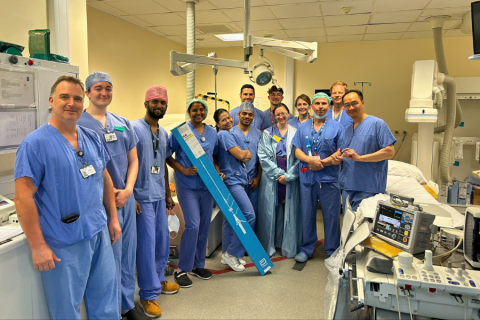A new pacemaker system to treat patients with complex heart rhythm conditions has been successfully implanted in patients for the first time in the UK at Royal Brompton Hospital and St Thomas’ Hospital.
The system is composed of two separate cylindrical devices, smaller than a AAA battery, which are implanted into two chambers of the heart via a catheter inserted through a blood vessel in the patient’s groin. The devices communicate with one another wirelessly to make the patient’s heart beat with a regular rhythm so that blood is pumped more efficiently around the body.
The first patient to receive the AVEIR dual chamber (DR) leadless pacemaker system in the UK at Royal Brompton Hospital is Mohamed Benkahoul, a 56-year-old from Surrey. He received the new pacemaker after his previous traditional pacemaker became infected and failed in 2022. His irregular heart rhythm was exacerbating problems associated with his advanced kidney disease, making it difficult for him to exercise and leading to problems with dialysis.
Mohamed said: “I feel really good now after my procedure. The surgery all went smoothly and I was able to go home the same day which was a relief to me. The staff were wonderful at the hospital and I felt very supported by my consultant throughout.
“I have been in and out of hospitals for a long time with my kidney problems and I am now hopeful because this new pacemaker should mean that those problems can be treated more successfully.”
Heart rhythm problems, or arrhythmias, are experienced by more than 2 million people in the UK. The heart rhythm service across Guy’s and St Thomas’ NHS Foundation Trust is one of the largest in the UK, providing highly specialised care for adults and children with arrhythmias.
Professor Tom Wong, consultant cardiologist and electrophysiologist at Royal Brompton Hospital, who carried out Mohamed’s procedure said: “This new technology allows us to offer a unique opportunity to treat patients like Mohamed who have complex heart disorders.
“The ability for the two individual pacemakers to work together to regulate the rhythm of separate chambers of the heart, is a major leap in technology that allow us to help a wider range of patients to improve their quality of life, and in some cases to extend their life expectancy.”
Leadless pacemakers are self-contained devices with no wires connecting the device to an external battery; they therefore offer a less restrictive and short recovery period after the procedure than traditional pacemakers and reduce the risk of complications arising from broken leads or infections.
The AVEIR DR pacemaker is also designed for long-term retrieval should a patient’s condition change, or if a replacement device is needed in the future.
Professor Aldo Rinaldi, consultant cardiologist and clinical lead for electrophysiology at St Thomas’ Hospital, who carried out the first cases at St Thomas’ said: “This new technology represents a significant benefit for our patients and may be particularly beneficial in certain patients who cannot receive a standard pacemaker with leads within the heart.
“There are no connecting wires to battery packs; no uncomfortable lumps under the skin; no scars on the chest; and importantly, patients are able to get back up onto their feet much quicker and don’t have to limit upper body activity after the procedure like they would with traditional pacemakers.”
Contact information
Media enquiries
Phone: 020 7188 5577
Email: press@gstt.nhs.uk

